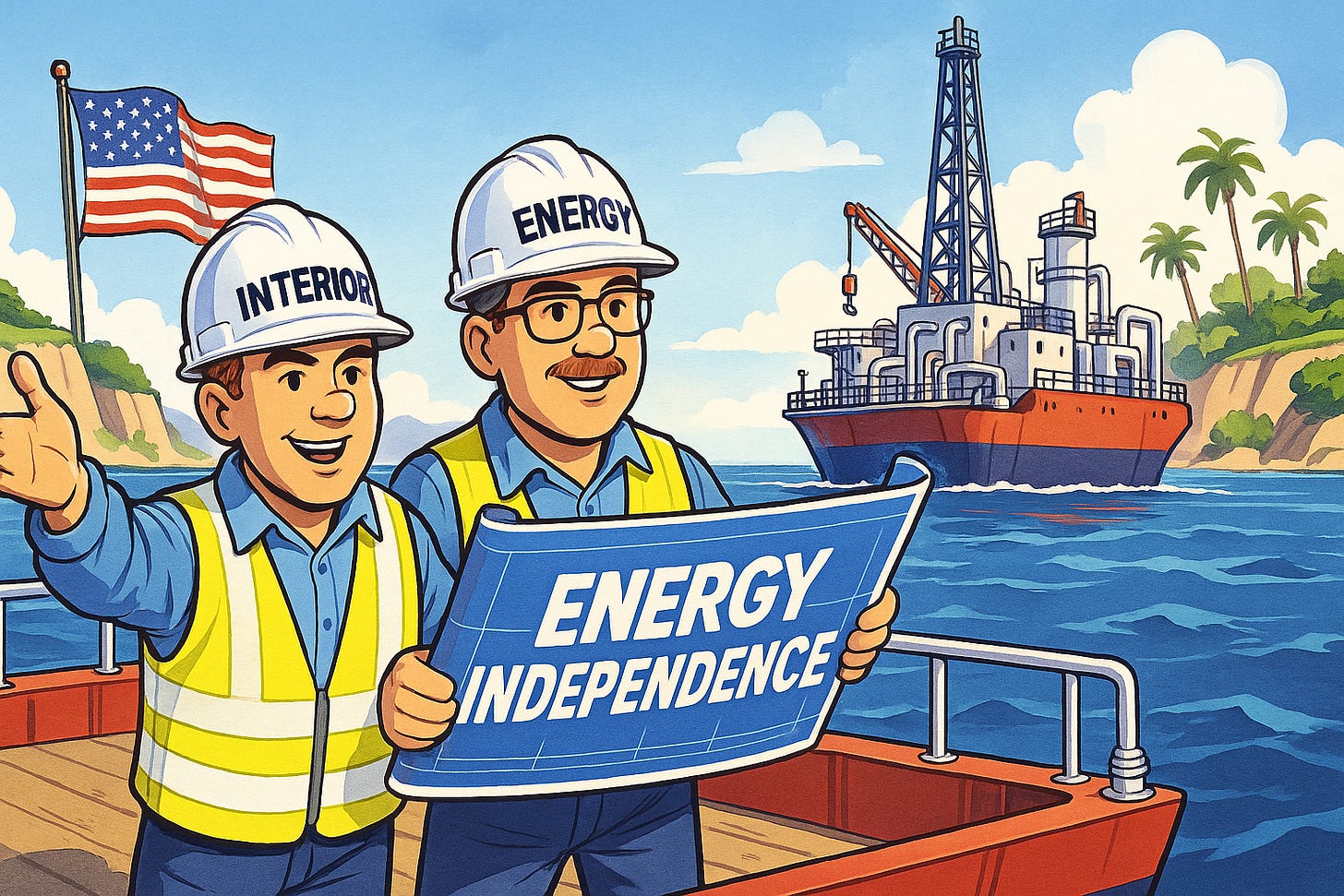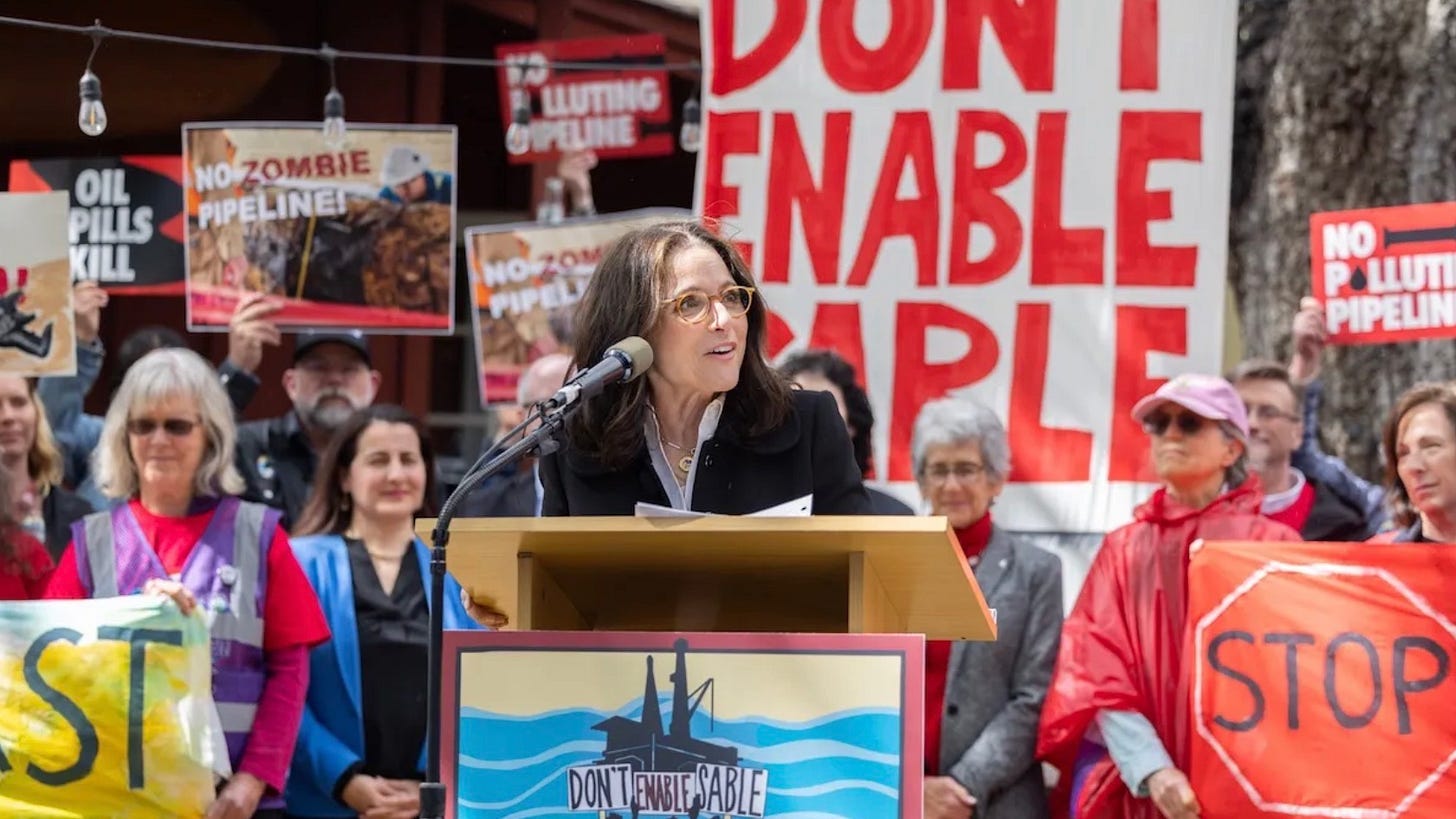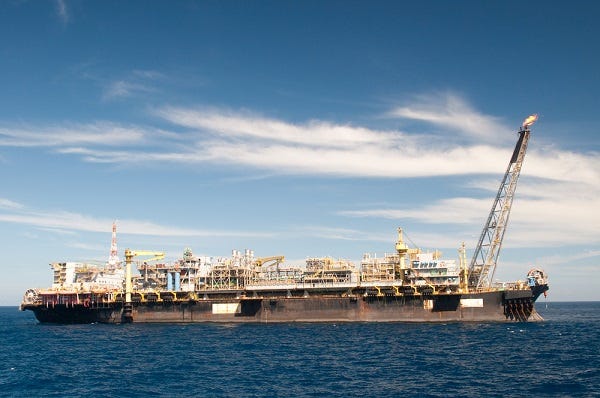*Breaking News* Trump Administration Being Asked to Green Light Oil Production Off Santa Barbara Coast
After blocking every pathway to restart Santa Barbara’s offshore oil, state leaders may have forced the feds to step in.
*Typically our afternoon post is for our paid subscribers, but since I’m breaking some news - everyone gets it!*
A Turning Point for Offshore Oil in Santa Barbara
Breaking news — reliable sources confirm that Sable Offshore Corporation, the operator of the offshore oil field off Santa Barbara County, is preparing to bypass California regulators altogether. After years of blocked permits, lawsuits, and even criminal charges, Sable intends to petition Washington to install a Offshore Storage & Treatment Vessel (OSTV) to bring this long-shuttered oil resource back to market, finally.
For years, Sable tried to work with California and Santa Barbara County to restart production in this oil-rich area off of the coast. Instead, they ran into a wall of obstruction. With California slamming the door on onshore solutions, the company has little choice but to go federal.
And with President Trump, who has made domestic energy production a top priority, this move could set the stage for California’s most significant energy showdown in decades.
A Federal Alternative
The path begins with the National Energy Dominance Council, a federal body created by President Trump in February by executive order. Chaired by Interior Secretary Doug Burgum and vice-chaired by Energy Secretary Chris Wright, the Council’s mission is to accelerate U.S. energy development by cutting red tape and strengthening security. Burgum and Wright have clarified that they are committed to expanding oil production.
Sable’s petition will likely argue that California has erected new barriers, making onshore transport of Santa Barbara crude impossible, while a floating production system is consistent with the original federal plan. An OSTV is not experimental; more than 200 operate worldwide, including several in U.S. waters. Federal law provides a clear pathway to allow safe development, and under President Trump’s directive, energy production is no longer to be strangled by obstructionism. Restarting offshore oil here could supply five percent of California’s demand, reduce imports, and enhance energy security — goals aligning with Trump’s national energy dominance vision.
If Sacramento insists on blocking Californians from their own resources, the federal government could intervene.
It Did Not Need to Go This Way
California’s standoff with Sable didn’t just happen. It was engineered.
Local activists and NGOs like the Environmental Defense Center, a Santa Barbara-based environmental law group, and the Sierra Club, one of the nation’s oldest environmental organizations, have opposed every restart plan. State agencies piled on. At a Santa Barbara hearing earlier this year, no fewer than a dozen bureaucracies testified. Even actress Julia Louis-Dreyfus showed up, throwing down on behalf of left-wing Hollywood.
But there’s more. The legislature passed, and the Governor just signed, a bill set to take effect in January that kills any onshore restart. And you can predict that state actors will stall out an approval until the new year, just to kill it. Oh yeah, Santa Barbara County District Attorney John Savrnoch went so far as to file criminal charges against Sable, which is nutty.
This is not policymaking — it’s trench warfare. And it comes at a steep price. Two refineries are closing. Production in the San Joaquin Valley continues to decline, and a new law to increase, frankly, is weak sauce. California Resources Corporation, the state’s largest independent oil and natural gas producer, is holding oil flat and pivoting to natural gas. Consumers pay record prices while politicians pat themselves on the back for “climate leadership.”
One side effect of forcing Sable down this federal path is that much, if not all, of the oil will be shipped to refineries outside California — even outside the U.S. — before returning here. That extra step adds cost, and Californians at the pump will bear the burden. It is an unforced error.
The world has changed since the Santa Barbara spill decades ago. Offshore safety technology has advanced dramatically. OSTVs are engineered with multiple containment systems, rapid shutdown features, and real-time monitoring. Pretending we are still in 1969 is reckless. But, again, the opposition was more ideological than practical.
It is especially shortsighted, given that President Trump has been explicit: America will achieve energy dominance by maximizing domestic resources, not importing from unstable or hostile regions. California may not like it, but Washington holds the cards.
What Is Being Proposed
For readers unfamiliar with the term, an Offshore Storage & Treatment Vessel is a floating production, storage, and offloading facility. Risers connect subsea wells to the vessel, which separates oil, gas, and water, stores crude in its hull, and offloads it to shuttle tankers. Think of it as a floating barge — a self-contained system that can process oil, store it, and transfer it directly to tankers bound for refineries and the marketplace.
More than 200 OSTVs, from the North Sea to Brazil to West Africa, are in service globally. Three operate in the Gulf of Mexico. They are not experimental; they are proven, regulated, and widely used.
For California, an OSTV off Santa Barbara would mean oil moving directly to market without relying on the county’s onshore infrastructure — state and local politicians have weaponized the chokepoint.
Be Careful What You Wish For
Here’s the irony. For years, California’s environmental lobby fought to shut down oil barging. They called it unsafe and polluting. And they won — pushing companies toward pipelines and onshore handling.
In 2011, Linda Krop, chief counsel at the Environmental Defense Center, cheered that ending barging would “protect the majority of the California coast.” The Sierra Club’s Los Padres chapter declared victory: “It’s about time that we protect our community and our coast from the risks of offshore oil barging.” 2012 the Environmental Defense Center claimed credit for ending marine oil shipping. And in 2013, their newsletter published a photo of Krop waving goodbye to what they thought was the last oil barge in Santa Barbara.
Fast-forward to 2025: Their refusal to accept pipelines and onshore handling has created the perfect opening for a federal OSTV. By slamming every door shut, they’ve invited Washington to walk in with a solution that will be harder to block.
Be careful what you wish for, indeed.
So, Does It Matter?
It matters because Californians are being held hostage by ideological rigidity. Families pay more at the pump while activists and legislators congratulate themselves for “protecting the coast.”
The OSTV plan off Santa Barbara is not perfect, but it is viable, lawful, and technologically advanced. Thanks to the state’s obstruction, it may soon be the only solution. And most importantly, it represents a “lifeline” for Californians who desperately need more access to oil to get relief from this affordability crisis.
President Trump’s administration is the only reason this option exists. California has spent years blocking its own people from their own resources. Washington, under Trump, is saying: no more.
It’s a good thing California is still part of America. Let’s not forget what Trump said in his inaugural address to the nation: “America will be a manufacturing nation once again, and we have something that no other manufacturing nation will ever have: the largest amount of oil and gas of any country on Earth.”





